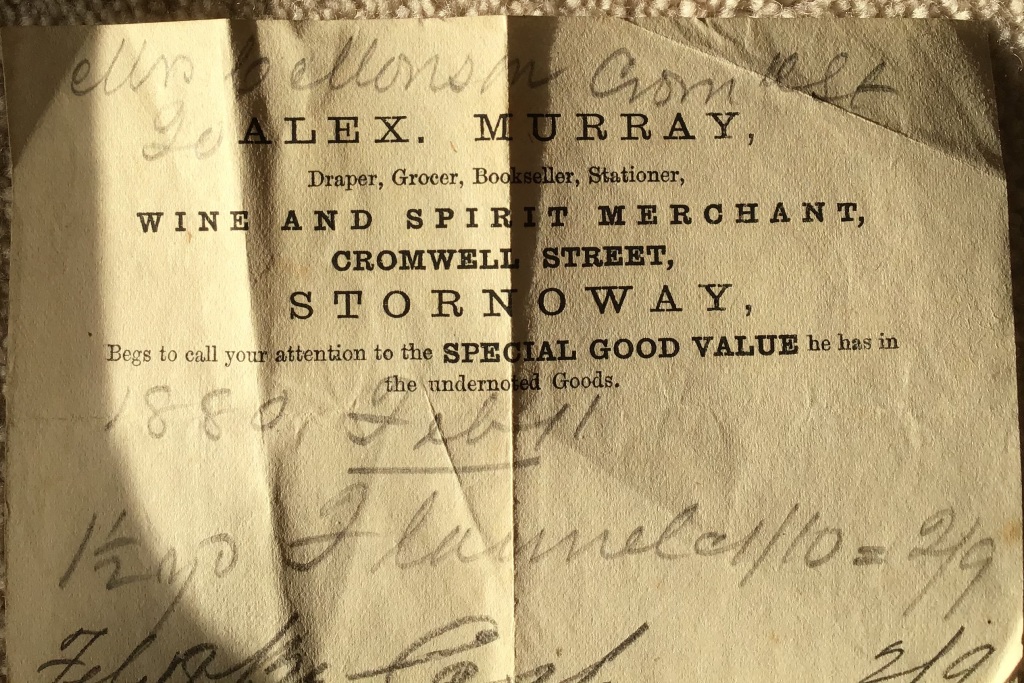The receipts published here relate to purchases made between 1868 and 1880 by Christina Morrison (Mrs Charles Morrison), then living in Cromwell Street in Stornoway, Isle of Lewis, with her shopkeeper husband and growing brood of small children.
With their florid mid-Victorian lettering, these slips of paper are a reminder of four long-forgotten Stornoway businesses.
They also yield a few surprises: a business run by two women; an extreme punishment for theft; the loss of a much-admired incomer, and a devious attempt to evade sequestration upon bankruptcy.

W. & A. Macpherson
In 1868 W. & A. Macpherson, dressmakers, charged Mrs Morrison 4s. 4d. for making a dress, including the price of thread. Mrs Morrison had no doubt supplied the material.
The receipt is signed ‘Annie Macpherson’. This was surely the Annie Macpherson, dressmaker, who was living with her father, George Macpherson, at 24 Bayhead, Stornoway, when the Census was taken in 1871.
Annie’s elder sister – the unusually named Winewood – was also listed as a dressmaker. It thus looks as if W. & A. Macpherson were not Willie and Alex (as one might assume in Stornoway!) but Winewood and Annie. A rare example of a Victorian business run by two women. When Christina patronised the Macphersons in 1868, Winewood and Annie were both in their mid-thirties and unmarried.

Kenneth Smith
In October 1877 Mrs Morrison bought a skirt from the shop of Kenneth Smith, general merchant, paying 8s. cash.
Kenneth Smith (1833-1904), fish curer and merchant, lived in the United Presbyterian Manse in Lewis Street. His extensive commercial premises ran through from 17 Cromwell Street to Kenneth Street. The frontage included a double shop (with two entrances), seemingly in the building currently occupied by Stornoway Library. Smith’s outbuildings were damaged in a great fire which devastated Cromwell Street in 1903, destroying James Mackenzie’s building further along the street.
One notable mention of Smith’s business crops up in newspapers in 1865, when a woman named Ann Macdonald was sentenced to eight years penal servitude for stealing unbleached cotton from Smith on four different occasions.

Fraser & Macleod
Fraser & Macleod, drapers and silk mercers, were located in Concrete Buildings on South Beach. This was three doors west of the Imperial Hotel, which later became the Louise Carnegie Hostel and is now the site of An Lanntair. Fraser & Macleod would therefore have been neighbours of Matthew Russell, general merchant, in Waverley Buildings on the corner of South Beach and Cromwell Street.
In August 1880 Mrs Morrison bought two straw hats from Fraser & Macleod. Each hat was priced 3s. 3d., so she paid a total of 6s. 6d. in cash.
In March 1881 Thomas Fraser left Stornoway to open a store in Inverness. The partnership of Fraser & Macleod had recently taken over the business of Robertson & Watt at Caledonian House, 25 Union Street, and cleared much of the old stock in their Stornoway premises. Fraser had been highly regarded in town and was treated to a farewell dinner with much speechifying in the Lews Hotel.

Alex. Murray
Alexander Murray was a draper, grocer, bookseller, stationer, wine and sprit merchant in Cromwell Street. In February 1880 Mrs Morrison bought 1½ yards of flannel from his shop for 2s. 9d.
Alexander Murray began his business in 1863 with £200 of his own money and a loan of £60 from a brother-in-law. He thrived until around 1870. Rather than living over his shop, he resided with his mother in the family home at 37 or 39 Keith Street (old numbering).
When he became insolvent in spring 1881 Murray tried to pull off a wily trick. He quickly transferred his firm to a new partnership comprising his 86-year-old mother, Margaret Morison or Murray, and his salesman, his young nephew William Stewart, who lived with his parents at 42 Keith Street (again, old numbering). The partnership (or ‘co-partnery’) continued the business under Alexander Murray’s name and management.
When Murray was declared bankrupt the partners claimed ownership of the assets. Not surprisingly, the legality of this move was robustly challenged by Murray’s creditors and the deed of partnership was dissolved. After an appeal failed, in November 1881, Murray’s bankrupt stock was disposed of at auction.
Murray subsequently vanishes from the historical record but, according to some unverified family trees, emigrated to California where he died in Los Angeles.
If you have information about these four shops, please post a comment below.
